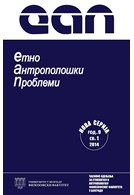Poreklo estetskih elemenata u tradicionalnim formama dalekoistočnih borilačkih veština
The origin of the aesthetic elements in traditional forms of Far-eastern martial arts
Author(s): Aleksandar FilipovićSubject(s): Aesthetics, Cultural Anthropology / Ethnology, Sociology of Culture, Sports Studies
Published by: Филозофски факултет, Универзитет у Београду
Keywords: martial arts; performance arts; aesthetic; movement; dance; body culture; yin and yang;
Summary/Abstract: In light of the fact that Far-eastern martial arts have to be viewed as an inseparable part of the cultural traditions of China and Japan, their aesthetic character is tied to traditional cultural concepts which dominate these cultures, such as the concept of the unity of opposites, better known as yin and yang; the concept of the Road (the Tao) as a symbol of continuing self-improvement; the concept of Chi or Qui energy which permeates the cosmos as well as individual beings, etc. These concepts owe their existence and development first and foremost to the religious and philosophical systems which shaped and influenced all segments of these two great cultures, and not just the martial tradition. On the other hand, performance arts weren’t spared this same influence. Performance arts and martial arts of the Far East had an intertwined history and strongly influenced each other. The aim of this paper will be to give an outline of the basic concepts connected to the aesthetics of the martial arts of China and Japan and point out the similar roots in other segments of cultural tradition.
Journal: Етноантрополошки проблеми
- Issue Year: 9/2014
- Issue No: 1
- Page Range: 145-156
- Page Count: 12
- Language: Serbian

